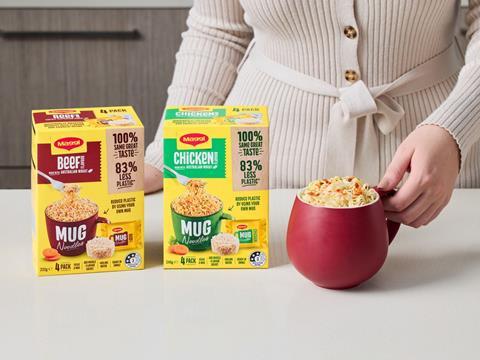
Nestlé’s Maggi brand has launched a new line of instant cup noodles designed to be prepared at home in a mug and thus cut down on plastic packaging by 83% compared to a plastic cup.
The Maggi Mug Noodles line encourages consumers to pour the product into a standard mug and add boiling water for instant preparation. This new format is expected to reduce plastic content by 83% - although the original plastic cup format will still be available for on-the-go consumption.
Available in four-packs and in chicken and beef flavours, the Mug Noodles are sold alongside Maggi’s 2-Minute Chicken and Beef Noodles products, said to be wrapped in 50% recycled plastic using the mass balance approach.
The brand anticipates that the development will contribute towards the brand’s sustainability goals as it seeks to lower the impact of its packaging.
Monique Koning, head of Marketing – Foods at Nestlé, said: “We know many of our consumers enjoy eating instant noodles in a cup at home – so we have re-thought the cup.
“The Maggi team is proud to be at the forefront of reducing plastic packaging in the instant noodle category. This is only the beginning of our journey.”
In another effort to minimize plastics in instant noodles packaging, Unilever’s Pot Noodle brand has trialled a new, FSC-certified paper pot exclusively at Tesco stores. Applying to its Chicken and Mushroom flavour, the new packs seek to phase out 4,000 tonnes of virgin plastic annually.
Nissin Foods USA made a similar move to replace the polystyrene cups for its Cup Noodles brand with a microwaveable paper alternative. As well as eliminating plastics, the move is expected to lower CO2 emissions and improve the pack’s convenience for consumers.
If you liked this article, you might also enjoy:
The Lidl approach to packaging sustainability
How did Brazil achieve its 100% aluminium can recycling rate – and can it be replicated in the EU?
Experts have their say on the EU’s Packaging and Packaging Waste Directive revisions
A deep dive into the most important packaging sustainability trends and solutions











No comments yet